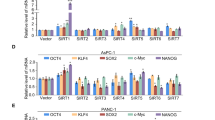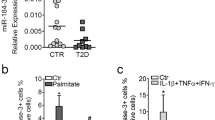Abstract
Iron metabolism is essential for many cellular processes, including oxygen transport, respiration and DNA synthesis, and many cancer cells exhibit dysregulation in iron metabolism. Maintenance of cellular iron homeostasis is regulated by iron regulatory proteins (IRPs), which control the expression of iron-related genes by binding iron-responsive elements (IREs) of target mRNAs. Here, we report that mitochondrial SIRT3 regulates cellular iron metabolism by modulating IRP1 activity. SIRT3 loss increases reactive oxygen species production, leading to elevated IRP1 binding to IREs. As a consequence, IRP1 target genes, such as the transferrin receptor (TfR1), a membrane-associated glycoprotein critical for iron uptake and cell proliferation, are controlled by SIRT3. Importantly, SIRT3 deficiency results in a defect in cellular iron homeostasis. SIRT3 null cells contain high levels of iron and lose iron-dependent TfR1 regulation. Moreover, SIRT3 null mice exhibit higher levels of iron and TfR1 expression in the pancreas. We found that the regulation of iron uptake and TfR1 expression contribute to the tumor-suppressive activity of SIRT3. Indeed, SIRT3 expression is negatively correlated with TfR1 expression in human pancreatic cancers. SIRT3 overexpression decreases TfR1 expression by inhibiting IRP1 and represses proliferation in pancreatic cancer cells. Our data uncover a novel role of SIRT3 in cellular iron metabolism through IRP1 regulation and suggest that SIRT3 functions as a tumor suppressor, in part, by modulating cellular iron metabolism.
This is a preview of subscription content, access via your institution
Access options
Subscribe to this journal
Receive 50 print issues and online access
$259.00 per year
only $5.18 per issue
Buy this article
- Purchase on SpringerLink
- Instant access to full article PDF
Prices may be subject to local taxes which are calculated during checkout






Similar content being viewed by others
References
Anderson CP, Shen M, Eisenstein RS, Leibold EA . Mammalian iron metabolism and its control by iron regulatory proteins. Biochim Biophys Acta 2012; 1823: 1468–1483.
Muckenthaler MU, Galy B, Hentze MW . Systemic iron homeostasis and the iron-responsive element/iron-regulatory protein (IRE/IRP) regulatory network. Annu Rev Nutr 2008; 28: 197–213.
Richardson DR, Kalinowski DS, Lau S, Jansson PJ, Lovejoy DB . Cancer cell iron metabolism and the development of potent iron chelators as anti-tumour agents. Biochim Biophys Acta 2009; 1790: 702–717.
Cheng Y, Zak O, Aisen P, Harrison SC, Walz T . Structure of the human transferrin receptor-transferrin complex. Cell 2004; 116: 565–576.
Wang J, Pantopoulos K . Regulation of cellular iron metabolism. Biochem J 2011; 434: 365–381.
Mueller S . Iron regulatory protein 1 as a sensor of reactive oxygen species. Biofactors 2005; 24: 171–181.
Tao R, Coleman MC, Pennington JD, Ozden O, Park SH, Jiang H et al. Sirt3-mediated deacetylation of evolutionarily conserved lysine 122 regulates MnSOD activity in response to stress. Mol Cell 2010; 40: 893–904.
Qiu X, Brown K, Hirschey MD, Verdin E, Chen D . Calorie restriction reduces oxidative stress by SIRT3-mediated SOD2 activation. Cell Metab 2010; 12: 662–667.
Bell EL, Guarente L . The SirT3 divining rod points to oxidative stress. Mol Cell 2011; 42: 561–568.
Someya S, Yu W, Hallows WC, Xu J, Vann JM, Leeuwenburgh C et al. Sirt3 mediates reduction of oxidative damage and prevention of age-related hearing loss under caloric restriction. Cell 2010; 143: 802–812.
Kim HS, Patel K, Muldoon-Jacobs K, Bisht KS, Aykin-Burns N, Pennington JD et al. SIRT3 is a mitochondria-localized tumor suppressor required for maintenance of mitochondrial integrity and metabolism during stress. Cancer Cell 2010; 17: 41–52.
Finley LW, Carracedo A, Lee J, Souza A, Egia A, Zhang J et al. SIRT3 opposes reprogramming of cancer cell metabolism through HIF1alpha destabilization. Cancer Cell 2011; 19: 416–428.
Pantopoulos K, Hentze MW . Activation of iron regulatory protein-1 by oxidative stress in vitro. Proc Natl Acad Sci USA 1998; 95: 10559–10563.
Lok CN, Ponka P . Identification of a hypoxia response element in the transferrin receptor gene. J Biol Chem 1999; 274: 24147–24152.
Tacchini L, Bianchi L, Bernelli-Zazzera A, Cairo G . Transferrin receptor induction by hypoxia. HIF-1-mediated transcriptional activation and cell-specific post-transcriptional regulation. J Biol Chem 1999; 274: 24142–24146.
Lu SC . Regulation of glutathione synthesis. Mol Aspects Med 2009; 30: 42–59.
Hentze MW, Muckenthaler MU, Andrews NC . Balancing acts: molecular control of mammalian iron metabolism. Cell 2004; 117: 285–297.
Rouault TA . The role of iron regulatory proteins in mammalian iron homeostasis and disease. Nat Chem Biol 2006; 2: 406–414.
Nunez-Millacura C, Tapia V, Munoz P, Maccioni RB, Nunez MT . An oxidative stress-mediated positive-feedback iron uptake loop in neuronal cells. J Neurochem 2002; 82: 240–248.
Wang J, Chen G, Muckenthaler M, Galy B, Hentze MW, Pantopoulos K . Iron-mediated degradation of IRP2, an unexpected pathway involving a 2-oxoglutarate-dependent oxygenase activity. Mol Cell Biol 2004; 24: 954–965.
Sanchez M, Galy B, Schwanhaeusser B, Blake J, Bahr-Ivacevic T, Benes V et al. Iron regulatory protein-1 and -2: transcriptome-wide definition of binding mRNAs and shaping of the cellular proteome by iron regulatory proteins. Blood 2011; 118: e168–e179.
Chen C, Garcia-Santos D, Ishikawa Y, Seguin A, Li L, Fegan KH et al. Snx3 regulates recycling of the transferrin receptor and iron assimilation. Cell Metab 2013; 17: 343–352.
Daniels TR, Delgado T, Rodriguez JA, Helguera G, Penichet ML . The transferrin receptor part I: Biology and targeting with cytotoxic antibodies for the treatment of cancer. Clin Immunol 2006; 121: 144–158.
O'Donnell KA, Yu D, Zeller KI, Kim JW, Racke F, Thomas-Tikhonenko A et al. Activation of transferrin receptor 1 by c-Myc enhances cellular proliferation and tumorigenesis. Mol Cell Biol 2006; 26: 2373–2386.
Ryschich E, Huszty G, Knaebel HP, Hartel M, Buchler MW, Schmidt J . Transferrin receptor is a marker of malignant phenotype in human pancreatic cancer and in neuroendocrine carcinoma of the pancreas. Eur J Cancer 2004; 40: 1418–1422.
Koppenol WH . The centennial of the Fenton reaction. Free Radic Biol Med 1993; 15: 645–651.
Zecca L, Youdim MB, Riederer P, Connor JR, Crichton RR . Iron, brain ageing and neurodegenerative disorders. Nat Rev Neurosci 2004; 5: 863–873.
Anderson SA, Nizzi CP, Chang YI, Deck KM, Schmidt PJ, Galy B et al. The IRP1-HIF-2alpha axis coordinates iron and oxygen sensing with erythropoiesis and iron absorption. Cell Metab 2013; 17: 282–290.
Wagner GR, Pride PM, Babbey CM, Payne RM . Friedreich's ataxia reveals a mechanism for coordinate regulation of oxidative metabolism via feedback inhibition of the SIRT3 deacetylase. Hum Mol Genet 2012; 21: 2688–2697.
Lobmayr L, Brooks DG, Wilson RB . Increased IRP1 activity in Friedreich ataxia. Gene 2005; 354: 157–161.
Schwer B, North BJ, Frye RA, Ott M, Verdin E . The human silent information regulator (Sir)2 homologue hSIRT3 is a mitochondrial nicotinamide adenine dinucleotide-dependent deacetylase. J Cell Biol 2002; 158: 647–657.
Bayeva M, Khechaduri A, Puig S, Chang HC, Patial S, Blackshear PJ et al. mTOR regulates cellular iron homeostasis through tristetraprolin. Cell Metab 2012; 16: 645–657.
Acknowledgements
We thank Ditte Lee and Annie Lee for technical assistance. We are also grateful to Alec C Kimmelman for providing cell lines and helpful discussions. This work was funded by a grant from Takeda Pharmaceuticals (to MCH). MCH is supported by NIH grant R01/AG032375, the American Cancer Society New Scholar Award and the Glenn Foundation for Medical Research.
Author information
Authors and Affiliations
Corresponding author
Ethics declarations
Competing interests
The authors declare no conflict of interest.
Additional information
Supplementary Information accompanies this paper on the Oncogene website
Supplementary information
Rights and permissions
About this article
Cite this article
Jeong, S., Lee, J., Finley, L. et al. SIRT3 regulates cellular iron metabolism and cancer growth by repressing iron regulatory protein 1. Oncogene 34, 2115–2124 (2015). https://doi.org/10.1038/onc.2014.124
Received:
Revised:
Accepted:
Published:
Issue date:
DOI: https://doi.org/10.1038/onc.2014.124
This article is cited by
-
Progress of Ferroptosis in Ischemic Stroke and Therapeutic Targets
Cellular and Molecular Neurobiology (2024)
-
Sirtuins as molecular targets, mediators, and protective agents in metal-induced toxicity
Archives of Toxicology (2021)
-
Using mitochondrial sirtuins as drug targets: disease implications and available compounds
Cellular and Molecular Life Sciences (2016)
-
The multifaceted functions of sirtuins in cancer
Nature Reviews Cancer (2015)



